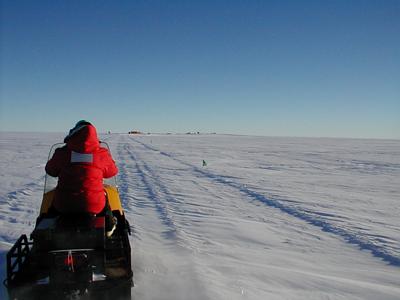21 November, 2000
Off to the Field
We left the U.S. seventeen days ago. It has been a long and interesting
journey. We have finally made it to our field camp!
Then final leg of the trip went smoothly. Ten passengers from four science
teams boarded an LC-130 at the sea ice runway. We took off under clear
skies, heading southeast across the vast Ross Ice Shelf. Our flight would
take us almost 1000 km (600 mi) to Siple Dome, part of the West Antarctic
Ice Sheet.
The plane was jammed with cargo but there was ample room to stretch out my
legs. After two hours we began a gentle descent. As we came down I looked
out the small porthole behind my seat. What looked like a vast ocean
covered with small ripples, stretched to the horizon. This ocean was white,
frozen, snow and ice.
Before the plane stopped the cargo was "drifted." That is when the loaded
pallets are rolled down a ramp and out the back door of the aircraft as it
taxis down the skiway. Stepping off the plane, I saw the tents and small
huts of the Siple Dome field camp. Beyond that, in all directions, was a
flat, featureless prairie of white.
After setting up our tents, Gary and Bob headed to the drill site on
snowmobiles with me in tow on a sled. The drill site, about three
kilometers (two miles) from camp, is where a hole was drilled 1000 meters
down to the bedrock. This location will be the focus of our project.

The LC-130 Hercules sits on the ice runway at McMurdo. Behind it is a DC-3 Basler, a new addition to the fleet.

Departing the plane at Siple Dome.

Approaching the drill site, 3 km from the field camp.
Contact the TEA in the field at
.
If you cannot connect through your browser, copy the
TEA's e-mail address in the "To:" line of
your favorite e-mail package.
|
